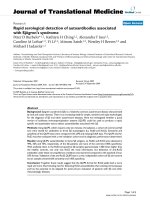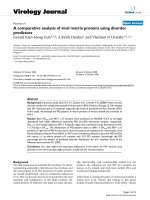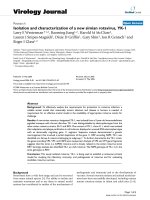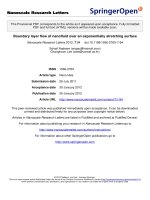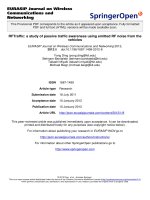Báo cáo toán học: " Boundary layer flow of nanofluid over an exponentially stretching surface" doc
Bạn đang xem bản rút gọn của tài liệu. Xem và tải ngay bản đầy đủ của tài liệu tại đây (606.44 KB, 26 trang )
This Provisional PDF corresponds to the article as it appeared upon acceptance. Fully formatted
PDF and full text (HTML) versions will be made available soon.
Boundary layer flow of nanofluid over an exponentially stretching surface
Nanoscale Research Letters 2012, 7:94 doi:10.1186/1556-276X-7-94
Sohail Nadeem ()
Changhoon Lee ()
ISSN 1556-276X
Article type Nano Idea
Submission date 26 July 2011
Acceptance date 30 January 2012
Publication date 30 January 2012
Article URL />This peer-reviewed article was published immediately upon acceptance. It can be downloaded,
printed and distributed freely for any purposes (see copyright notice below).
Articles in Nanoscale Research Letters are listed in PubMed and archived at PubMed Central.
For information about publishing your research in Nanoscale Research Letters go to
/>For information about other SpringerOpen publications go to
Nanoscale Research Letters
© 2012 Nadeem and Lee ; licensee Springer.
This is an open access article distributed under the terms of the Creative Commons Attribution License ( />which permits unrestricted use, distribution, and reproduction in any medium, provided the original work is properly cited.
Boundary layer flow of nanofluid over
an exponentially stretching surface
Sohail Nadeem
∗1
and Changhoon Lee
2
1
Department of Mathematics, Quaid-i-Azam University,
45320, Islamabad 44000, Pakistan
2
Department of Computational Science and Engineering,
Yonsei University, Seoul, Korea
∗
Corresponding author:
Email address:
CL:
Abstract
The steady boundary layer flow of nanofluid over an exponential
stretching surface is investigated analytically. The transport equations
include the effects of Brownian motion parameter and thermophoresis
parameter. The highly nonlinear coupled partial differential equations
are simplified with the help of suitable similarity transformations. The
reduced equations are then solved analytically with the help of homo-
topy analysis method (HAM). The convergence of HAM solutions are
obtained by plotting h-curve. The expressions for velocity, tempera-
ture and nanoparticle volume fraction are computed for some values of
the parameters namely, suction injection parameter α, Lewis number
Le, the Brownian motion parameter N b and thermophoresis parame-
ter N t.
Keywords: nanofluid; porous stretching surface; boundary layer flow;
series solutions; exponential stretching.
1
1 Introduction
During the last many years, the study of boundary layer flow and heat trans-
fer over a stretching surface has achieved a lot of success because of its large
numb er of applications in industry and technology. Few of these applications
are materials manufactured by polymer extrusion, drawing of copper wires,
continuous stretching of plastic films, artificial fibers, hot rolling, wire draw-
ing, glass fiber, metal extrusion and metal spinning etc. After the pioneering
work by Sakiadis [1], a large amount of literature is available on boundary
layer flow of Newtonian and non-Newtonian fluids over linear and nonlinear
stretching surfaces [2–10]. However, only a limited attention has been paid
to the study of exponential stretching surface. Mention may be made to the
works of Magyari and Keller [11], Sanjayanand and Khan [12], Khan and
Sanjayanand [13], Bidin and Nazar [14] and Nadeem et al. [15–16].
More recently, the study of convective heat transfer in nanofluids has
achieved great success in various industrial processes. A large number of
experimental and theoretical studies have been carried out by numerous
researchers on thermal conductivity of nanofluids [17–22]. The theory of
nanofluids has presented several fundamental properties with the large en-
hancement in thermal conductivity as compared to the base fluid [23].
In this study, we have discussed the boundary layer flow of nanofluid over
an exponentially stretching surface with suction and injection. To the best of
our knowledge, the nanofluid over an exponentially stretching surface has not
been discussed so far. However, the present paper is only a theoretical idea,
which is not checked experimentally. The governing highly nonlinear partial
differential equation of motion, energy and nanoparticle volume fraction has
been simplified by using suitable similarity transformations and then solved
analytically with the help of HAM [24–39]. The convergence of HAM solution
has been discussed by plotting h-curve. The effects of pertinent parameters
of nanofluid have been discussed through graphs.
2 Formulation of the problem
Consider the steady two-dimensional flow of an incompressible nanofluid over
an exponentially stretching surface. We are considering Cartesian coordinate
system in such a way that x-axis is taken along the stretching surface in the
direction of the motion and y-axis is normal to it. The plate is stretched in
2
the x-direction with a velocity U
w
= U
0
exp (x/l) defined at y = 0. The flow
and heat transfer characteristics under the boundary layer approximations
are governed by the following equations
∂u
∂x
+
∂v
∂y
= 0, (1)
u
∂u
∂x
+ v
∂u
∂y
= ν
∂
2
u
∂y
2
, (2)
u
∂T
∂x
+ v
∂T
∂y
= α
∂
2
T
∂y
2
+
(ρc)
p
(ρc)
f
D
B
∂C
∂y
∂T
∂y
+
D
T
T
∞
∂T
∂y
2
, (3)
u
∂C
∂x
+ v
∂C
∂y
= D
B
∂
2
C
∂y
2
+
D
T
T
∞
∂
2
T
∂y
2
, (4)
where (u, v) are the velocity components in (x, y) directions, ρ
f
is the
fluid density of base fluid, ν is the kinematic viscosity, T is the temperature,
C is the nanoparticle volume fraction, (ρc)
p
is the effective heat capacity
of nanoparticles, (ρc)
f
is the heat capacity of the fluid, α = k/ (ρc)
f
is the
thermal diffusivity of the fluid, D
B
is the Brownian diffusion coefficient and
D
T
is the thermophoretic diffusion coefficient.
The corresponding boundary conditions for the flow problem are
u = U
w
(x) = U
0
exp (x/l ) , v = −β (x) , T = T
w
, C = C
w
at y = 0,
u = 0, T = T
∞
C = C
∞
as y → ∞, (5)
in which U
0
is the reference velocity, β (x) is the suction and injection velocity
when β (x) > 0 and β (x) < 0, respectively, T
w
and T
∞
are the temperatures
of the sheet and the ambient fluid, C
w
, C
∞
are the nanoparticles volume
fraction of the plate and the fluid, respectively.
We are interested in similarity solution of the above boundary value prob-
lem; therefore, we introduce the following similarity transformations
u = U
0
exp
x
l
f
(η) , v = −
υU
0
2l
exp
x
2l
f (η) + ηf
(η)
, (6)
η = y
U
0
2υl
exp
x
2l
, θ =
T −T
∞
T
w
− T
∞
, g =
C − C
∞
C
w
− C
∞
.
3
Making use of transformations (6), Eq. (1) is identically satisfied and
Equations (2)–(4) take the form
f
ηηη
+ ff
ηη
− 2f
2
η
= 0, (7)
θ
ηη
+ Pr
fθ
η
− f
η
θ + Nbθ
η
g
η
+ Ntθ
2
η
= 0 (8)
g
ηη
+ Le (fg
η
− f
η
g) +
Nt
Nb
θ
ηη
= 0, (9)
f = −v
w
, f
η
= 1, θ = 1, g = 1 at η = 0, (10)
f
η
→ 0, θ → 0, g → 0 as η → ∞,
where
Nt = D
B
(ρc)
p
(ρc)
f
(C
w
− C
∞
) , Nb =
D
T
T
∞
(ρc)
p
(ρc)
f
(T
w
− T
∞
)
υ
, Le =
υ
D
B
, Pr =
υ
α
.
The physical quantities of interest in this problem are the local skin-friction
coefficient C
f
, Nusselt number Nu
x
and the local Sherwood number Sh
x
,
which are defined as
C
f
x
=
τ
w
|
y=0
ρU
2
0
e
2x
l
, Nu
x
= −
x
(T
w
− T
∞
)
∂T
∂y
y=0
, Sh
x
= −
x
(C
w
− C
∞
)
∂C
∂y
y=0
,
√
2ReC
f
x
= f
(0) , Nu
x
/
2Re
x
= −
x
2l
θ
(0) , Sh
x
/
2Re
x
= −
x
2l
g
(0) ,(11)
where Re
x
= U
w
x/ν is the local Renolds number.
3 Solution by homotopy analysis method
For HAM solutions, the initial guesses and the linear operators L
i
(i = 1 − 3)
are
f
0
(η) = 1 −v
w
− e
−η
, θ
0
(η) = e
−η
, g
0
(η) = e
−η
, (12)
L
1
(f) = f
− f
, L
2
(θ) = θ
− θ, L
3
(g) = g
− g. (13)
4
The operators satisfy the following properties
L
1
c
1
e
−η
+ c
2
e
η
+ c
3
= 0, (14)
L
2
c
4
e
−η
+ c
5
e
η
= 0, (15)
L
3
c
6
e
−η
+ c
7
e
η
= 0, (16)
in which C
1
to C
7
are constants. From Equations (7) to (9), we can define
the following zeroth-order deformation problems
(1 − p ) L
1
ˆ
f (η, p) − f
0
(η)
= p
1
H
1
˜
N
1
ˆ
f (η, p)
, (17)
(1 − p) L
2
ˆ
θ (η, p) −θ
0
(η)
= p
2
H
2
˜
N
2
ˆ
θ (η, p)
, (18)
(1 − p ) L
3
[ˆg (η, p) − g
0
(η)] = p
3
H
3
˜
N
3
[ˆg (η, p)] , (19)
ˆ
f (0, p) = −v
w
,
ˆ
f
(0, p) = 1,
ˆ
f
(∞, p) = 0, (20)
ˆ
θ (0, p) = 1,
ˆ
θ (∞, p) = 0, (21)
ˆg
(0, p) = 1, ˆg (∞, p) = 0. (22)
In Equations (17)–(22),
1
,
2
,and
3
denote the non-zero auxiliary pa-
rameters, H
1
, H
2
and H
3
are the non-zero auxiliary function (H
1
= H
2
=
H
3
= 1) and
˜
N
1
ˆ
f (η, p)
=
∂
3
f
∂η
3
− 2
∂f
∂η
2
+ f
∂
2
f
∂η
2
, (23)
˜
N
2
ˆ
θ (η, p)
=
∂
2
θ
∂η
2
+ Pr
f
∂θ
∂η
−
∂f
∂η
θ + Nb
∂θ
∂η
∂g
∂η
+ Nt
∂θ
∂η
2
, (24)
˜
N
3
[ˆg (η, p)] =
∂
2
g
∂η
2
+ Le
f
∂g
∂η
−
∂f
∂η
g +
Nt
Nb
θ
ηη
+
Nt
Nb
∂
2
θ
∂η
2
. (25)
5
Obviously
ˆ
f (η, 0) = f
0
(η) ,
ˆ
f (η, 1) = f (η) , (26)
ˆ
θ (η, 0) = θ
0
(η) ,
ˆ
θ (η, 1) = θ (η) , (27)
ˆg (η, 0) = g
0
(η) , ˆg (η , 1) = g (η) . (28)
When p varies from 0 to 1, then
ˆ
f (η, p) ,
ˆ
θ (η, p) , ˆg (η, p) vary from ini-
tial guesses f
0
(η) , θ
0
(η) , and g
0
(η) to the final solutions f (η) , θ (η) and
g (η), respectively. Considering that the auxiliary parameters
1
,
2
and
3
are so properly chosen that the Taylor series of
ˆ
f (η, p) ,
ˆ
θ (η, p) and ˆg (η, p)
expanded with respect to an embedding parameter converge at p = 1, hence
Equations (17)–(19) b ecome
ˆ
f (η, p) = f
0
(η) +
∞
m=1
f
m
(η) p
m
, (29)
ˆ
θ (η, p) = θ
0
(η) +
∞
m=1
θ
m
(η) p
m
, (30)
ˆg (η, p) = g
0
(η) +
∞
m=1
g
m
(η) p
m
, (31)
f
m
(η) =
1
m!
∂
m
ˆ
f (η, p)
∂p
m
p=0
, (32)
θ
m
(η) =
1
m!
∂
m
ˆ
θ (η, p)
∂p
m
p=0
, (33)
g
m
(η) =
1
m!
∂
m
ˆg (η, p)
∂p
m
p=0
. (34)
The mth-order problems are defined as follow
L
1
[f
m
(η) − χ
m
f
m−1
(η)] =
1
ˇ
R
1
m
(η) , (35)
L
2
[θ
m
(η) − χ
m
θ
m−1
(η)] =
2
ˇ
R
2
m
(η) , (36)
L
3
[g
m
(η) − χ
m
g
m−1
(η)] =
3
ˇ
R
3
m
(η) , (37)
6
f
m
(0) = f
m
(0) = f
m
(∞) = 0, (38)
θ
m
(0) = θ
m
(∞) = 0, (39)
g
m
(0) = g
m
(∞) = 0, (40)
where
χ
m
=
0, m ≤ 1,
1, m > 1.
(41)
ˇ
R
1
m
(η) = f
m−1
(η) +
m−1
k=0
f
m−1−k
f
k
− 2
m−1
k=0
f
m−1−k
f
k
, (42)
ˇ
R
2
m
(η) = θ
m−1
+Pr
m−1
k=0
f
m−1−k
θ
k
− f
m−1−k
θ
k
+ Nbθ
m−1−k
g
k
+ Ntθ
m−1−k
θ
k
,
(43)
ˇ
R
3
m
(η) = g
m−1
+ Le
m−1
k=0
f
m−1−k
g
k
− f
m−1−k
g
k
+
Nt
Nb
θ
m−1
. (44)
Employing MATHEMATICA, Equations (35)–(40) have the following so-
lutions
f (η) =
∞
m=0
f
m
(η) = lim
M→∞
M
m=0
a
0
m,0
+
M+1
n=1
e
−nη
M
m=n−1
m+1−n
k=0
a
k
m,n
η
k
,
(45)
θ (η) =
∞
m=0
θ
m
(η) = lim
M→∞
M+2
n=1
e
−nη
M+1
m=n−1
m+1−n
k=0
A
k
m,n
η
k
, (46)
g (η) =
∞
m=0
g
m
(η) = lim
M→∞
M+2
n=1
e
−nη
M+1
m=n−1
m+1−n
k=0
F
k
m,n
η
k
, (47)
in which a
0
m,0
, a
k
m,n
, A
k
m,n
, F
k
m,n
are the constants and the numerical data
of above solutions are shown through graphs in the following section.
7
4 Results and discussion
The numerical data of the solutions (45)–(47), which is obtained with the
help of Mathematica, have been discussed through graphs. The convergence
of the series solutions strongly depends on the values of non-zero auxiliary
parameters
i
(i = 1, 2, 3, h
1
= h
2
= h
3
), which can adjust and control the
convergence of the solutions. Therefore, for the convergence of the solution,
the -curves is plotted for velocity field in Figure 1. We have found the con-
vergence region of velocity for different values of suction injection parameter
v
w
. It is seen that with the increase in suction parameter v
w
, the convergence
region become smaller and smaller. Almost similar kind of convergence re-
gions appear for temperature and nanoparticle volume fraction, which are
not shown here. The non-dimensional velocity f
against η for various values
of suction injection parameter is shown in Figure 2. It is observed that veloc-
ity field increases with the increase in v
w
. Moreover, the suction causes the
reduction of the boundary layer. The temperature field θ for different val-
ues of Prandtle number Pr, Brownian parameter Nb, Lewis number Le and
thermophoresis parameter Nt is shown in Figures 3, 4, 5 and 6. In Figure 3,
the temperature is plotted for different values of Pr . It is observed that with
the increase in Pr, there is a very slight change in temperature; however, for
very large Pr, the solutions seem to be unstable, which are not shown here.
The variation of Nb on θ is shown in Figure 4. It is depicted that with the
increase in Nb, the temperature profile increases. There is a minimal change
in θ with the increase in Le (see Figure 5). The results remain unchanged
for very large values of Le. The effects of Nt on θ are seen in Figure 6. It is
seen that temperature profile increases with the increase in Nt; however, the
thermal boundary layer thickness reduces. The nanoparticle volume fraction
g for different values of Pr, Nb, Nt and Le is plotted in Figures 7, 8, 9 and 10.
It is observed from Figure 7 that with the increase in Nb, g decreases and
boundary layer for g also decreases. The effects of Pr on g are minimal. ( See
Figure 8). The effects of Le on g are shown in Figure 9. It is observed that g
decreases as well as layer thickness reduces with the increase in Le. However,
with the increase in Nt, g increases and layer thickness reduces (See Figure
10).
8
Competing interests
This is just the theoretical study, every experimentalist can check it experi-
mentally with our consent.
Authors’ contributions
SN done the major part of the article; however, the funding and computa-
tional suggestions and proof reading has been done by CL. All authors read
and approved the final manuscript.
Acknowledgments
This research was supported by WCU (World Class University) program
through the National Research Foundation of Korea (NRF) funded by the
Ministry of Education, Science and Technology R31-2008-000-10049-0.
References
[1] Sakiadis BC: Boundary layer behavior on continuous solid sur-
faces: I Boundary layer equations for two dimensional and ax-
isymmetric flow. AIChE J 1961, 7:26–28.
[2] Liu IC: Flow and heat transfer of an electrically conducting fluid
of second grade over a stretching sheet subject to a transverse
magnetic field. Int J Heat Mass Transf 2004, 47: 4427–4437.
[3] Vajravelu K, Rollins D: Heat transfer in electrically conducting
fluid over a stretching surface. Int J Non-Linear Mech 1992, 27(2):
265–277.
[4] Vajravelu K, Nayfeh J: Convective heat transfer at a stretching
sheet. Acta Mech 1993, 96(1–4): 47–54.
[5] Khan SK, Subhas Abel M, Sonth Ravi M: Viscoelastic MHD flow,
heat and mass transfer over a porous stretching sheet with
dissipation of energy and stress work. Int J Heat Mass Transf
2003, 40: 47–57.
9
[6] Cortell R: Effects of viscous dissipation and work done by de-
formation on the MHD flow and heat transfer of a viscoelastic
fluid over a stretching sheet. Phys Lett A 2006, 357: 298–305.
[7] Dandapat BS, Santra B, Vajravelu K: The effects of variable fluid
properties and thermocapillarity on the flow of a thin film on
an unsteady stretching sheet. Int J Heat Mass Transf 2007, 50:
991–996.
[8] Nadeem S, Hussain A, Malik MY, Hayat T: Series solutions for the
stagnation flow of a second-grade fluid over a shrinking sheet.
Appl Math Mech Engl Ed 2009, 30: 1255–1262.
[9] Nadeem S, Hussain A, Khan M: HAM solutions for boundary layer
flow in the region of the stagnation point towards a stretching
sheet. Comm Nonlinear Sci Numer Simul 2010, 15 475–481.
[10] Afzal N: Heat transfer from a stretching surface. Int J Heat Mass
Transf 1993, 36: 1128–1131.
[11] Magyari E, Keller B: Heat and mass transfer in the boundary
layer on an exponentially stretching continuous surface. J Phys
D Appl Phys 1999, 32: 577–785.
[12] Sanjayanand E, Khan SK: On heat and mass transfer in a vis-
coelastic boundary layer flow over an exponentially stretching
sheet. Int J Therm Sci 2006, 45: 819–828.
[13] Khan SK, Sanjayanand E: Viscoelastic boundary layer flow and
heat transfer over an exponential stretching sheet. Int J Heat
Mass Transf 2005, 48: 1534–1542.
[14] Bidin B, Nazar R: Numerical solution of the boundary layer flow
over an exponentially stretching sheet with thermal radiation.
Eur J Sci Res 2009, 33: 710–717.
[15] Nadeem S, Hayat T, Malik MY, Rajput SA: Thermal radiations ef-
fects on the flow by an exponentially stretching surface: a series
solution. Zeitschrift fur Naturforschung (2010), 65a: 1–9.
10
[16] Nadeem S, Zaheer S, Fang T: Effects of thermal radiations on the
boundary layer flow of a Jeffrey fluid over an exponentially
stretching surface. Numer Algor 2011, 57: 187–205.
[17] Bachok N, Ishak A, Pop I: boundary Layer flow of nanofluid over
a moving surface in a flowing fluid. Int J Therm Sci 2010, 49:
1663–1668.
[18] Choi SUS: Enhancing thermal conductivity of fluids with
nanoparticle. In Developments and Applications of Non-Newtonian
Flows, Volume 66. Edited by Siginer DA, Wang HP. ASME FED
231/MD 1995:99–105.
[19] Khanafer K, Vafai K, Lightstone M: Buoyancy driven heat transfer
enhancement in a two dimensional enclosure utilizing nanoflu-
ids. Int J Heat Mass Transf 2003, 46: 3639–3653.
[20] Makinde OD, Aziz A: Boundary layer flow of a nano fluid past
a stretching sheet with a convective boundary condition. Int J
Therm Sci 2011, 50: 1326–1332.
[21] Bayat J, Nikseresht AH: Investigation of the different base fluid
effects on the nanofluids heat transfer and pressure drop. Heat
Mass Transf. doi:10.1007/s00231-011-0773-0.
[22] Hojjat M, Etemad SG, Bagheri R: Laminar heat transfer of
nanofluid in a circular tube. Korean J. Chem Eng 2010, 27(5):
1391-*1396.
[23] Fan J, Wang L: Heat conduction in nanofluids: structure-
property correlation. Int J Heat Mass Transf 2011, 54: 4349–4359.
[24] Liao SJ: Beyond Perturbation Introduction to Homotopy Analysis
Method. Boca Raton: Chapman & Hall/CRC Press; 2003.
[25] Abbasbandy S: The application of homotopy analysis method to
nonlinear equations arising in heat transfer. Phys Lett A 2006,
360: 109–113.
[26] Abbasbandy S: Homotopy analysis method for heat radiation
equations. Int Commun Heat Mass Transf 2007, 34: 380–387.
11
[27] Abbasbandy S, Tan Y, Liao SJ: Newton-homotopy analysis method
for nonlinear equations. Appl Math Comput 2007, 188: 1794–1800.
[28] Abbasbandy S: Approximate solution for the nonlinear model
of diffusion and reaction in porous catalysts by means of the
homotopy analysis method. Chem Eng J 2008, 136: 144–150.
[29] Abbasbandy S: Soliton solutions for the Fitzhugh–Nagumo equa-
tion with the homotopy analysis method. Appl Math Model 2008,
32: 2706–2714.
[30] Tan Y, Abbasbandy S: Homotopy analysis method for quadratic
Ricati differential equation. Comm Non-linear Sci Numer Simm
2008, 13: 539–546.
[31] Alomari AK, No orani MSM, Nazar R: Adaptation of homo-
topy analysis method for the numeric–analytic solution
of Chen system. Commun Nonlinear Sci Numer Simulat (2008),
doi:10.1016/j.cnsns.2008.06.011.
[32] Rashidi MM, Domairry G, Dinarvand S: Approximate solutions for
the Burger and regularized long wave equations by means of
the homotopy analysis method. Commun Nonlinear Sci Numer
Simul 2009, 14: 708–717.
[33] Chowdhury MSH, Hashim I, Abdulaziz O: Comparison of homo-
topy analysis method and homotopy-perturbation method for
purely nonlinear fin-type problems. Commun Nonlinear Sci Numer
Simul 2009, 14: 371–378.
[34] Sami Bataineh A, Noorani MSM, Hashim I: On a new reliable mod-
ification of homotopy analysis method. Commun Nonlinear Sci
Numer Simul 2009, 14: 409–423.
[35] Sami Bataineh A, Noorani MSM, Hashim I: Modified homotopy
analysis method for solving systems of second-order BVPs.
Commun Nonlinear Sci Numer Simul 2009, 14: 430–442.
[36] Sami Bataineh A, Noorani MSM, Hashim I: Solving systems of
ODEs by homotopy analysis method. Commun Nonlinear Sci Nu-
mer Simul 2008, 13: 2060–2070.
12
[37] Sajid M, Ahmad I, Hayat T, Ayub M: Series solution for unsteady
axisymmetric flow and heat transfer over a radially stretching
sheet. Commun Nonlinear Sci Numer Simul 2008, 13: 2193–2202.
[38] Nadeem S, Hussain A: MHD flow of a viscous fluid on a non linear
porous shrinking sheet with HAM. Appl Math Mech Engl Ed 2009,
30: 1–10.
[39] Nadeem S, Abbasbandy S, Hussain M: Series solutions of bound-
ary layer flow of a Micropolar fluid near the stagnation point
towards a shrinking sheet. Z Naturforch 2009, 64a:575–582.
13
Figure 1: h-Curve for velocity.
Figure 2: Velocity for different values of suction and injection pa-
rameter.
14
Figure 3: Variation of temperature for different values of Pr when
Le = 2, h = −0.1, Nt = Nb = 0.5, v
w
= 1.
Figure 4: Variation of temperature for different values of
Nb when Le = 2, h = −0.1, Nt = 0.5, v
w
= 1, Pr = 2.
Figure 5: Variation of temperature for different values of
Le when h = −0.1, Nt = Nb = 0.5, v
w
= 1, Pr = 2.
Figure 6: Variation of temperature for different values of
Nt when Le = 2, h = −0.1, Nb = 0.5, v
w
= 1, Pr = 2.
Figure 7: Variation of nanoparticle fraction g for different values
of Nb when Le = 2, h = −0.1, Nt = 0.5, v
w
= 1, Pr = 2.
Figure 8: Variation of nanoparticle fraction g for different values
of Pr when Le = 2, h = −0.1, Nt = 0.5, v
w
= 1, Nb = 0.5.
Figure 9: Variation of nanoparticle fraction g for different values
of Le when Pr = 2, h = −0.1, Nt = 0.5, v
w
= 1, Nb = 0.5.
Figure 10: Variation of nanoparticle fraction g for different values
of Nt when Le = 2, h = −0.1, Nt = 0.5, v
w
= 1, Pr = 2.
15
Figure 1
Figure 2
Figure 3
Figure 4
Figure 5
Figure 6
Figure 7
Figure 8
Figure 9
